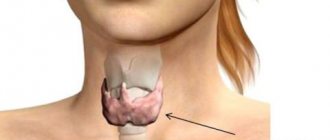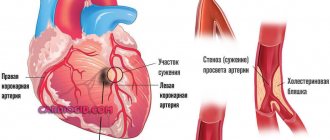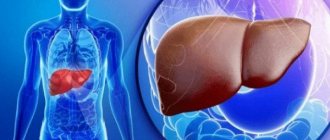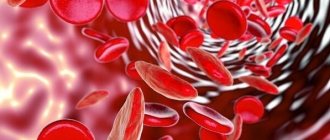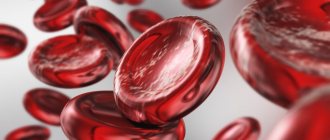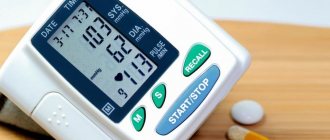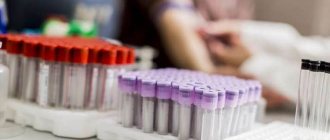Complexes with this research
Healthy interest Preventive examination to assess the general condition of the body RUB 4,250 Composition
Biomarkers of liver functional capacity RUB 2,760 Composition
Biochemistry of blood. 19 indicators Advanced biochemical blood test 6,280 ₽ Composition
IN OTHER COMPLEXES
- Check-up No. 1 for children and teenagers RUB 10,950
- Biomarkers of liver functional capacity. Extended examination RUB 3,900
- Liver and pancreas RUB 3,050
- Women's check-up No. 1 RUB 19,290
- Biochemistry of blood. 13 indicators 3,490 ₽
Treatment of elevated GGT in the blood: how to lower and return to normal
Treatment of elevated GGT levels begins with diagnosing the condition of the body and identifying the exact cause of the increase in this enzyme. Treatment of diseases that cause increased gamma-glutamyl transferase can reduce its level.
In addition to drug treatment, it is necessary to adjust your diet. A menu rich in fruits and vegetables helps reduce GGT. First of all, these are plant foods rich in vitamin C, fiber, beta-carotene and folic acid:
- carrot;
- leaf salad;
- spinach;
- apricots;
- pumpkin.
It is necessary to stop smoking and drinking alcohol. Recommendations from the World Health Organization on how to quit smoking and how to stop drinking will help you get rid of these habits.
- increased ALT and AST - increased bilirubin - platelets above and below normal - increased and decreased albumin
Treatment of elevated GGT levels begins with diagnosing the condition of the body and identifying the exact cause of the increase in this enzyme. Treatment of diseases that cause increased gamma-glutamyl transferase can reduce its level.
It is necessary to stop smoking and drinking alcohol. Recommendations from the World Health Organization on how to quit smoking and how to stop drinking will help you get rid of these habits.
To diagnose diseases of the liver or pancreas, you can donate blood from a vein for GGT. This abbreviation stands for gamma-glutamyl transpeptidase. If you receive results in which the gamma of HT is increased, then this may indicate gallstones, toxic liver damage, alcoholism, diabetes mellitus, pancreatitis in the acute or chronic phase, hyperthyroidism, even prostate, liver or pancreatic cancer.
Detailed description of the study
The study shows the level of gamma-glutamyl transferase activity in the blood serum. Used to diagnose pathologies and assess the functions of the liver, biliary tract, and pancreas.
Gamma-GT (gamma-glutamyltransferase) is a microsomal enzyme that plays the role of a catalyst for some biochemical processes. In cells, the enzyme is found in the membrane, cytoplasm and lysosomes. Most of the gamma-GT is secreted by the cells of the liver and pancreas. It is also produced in the prostate, spleen, kidneys and brain, but in smaller quantities.
An increase in the level of gamma-GT in the blood is observed during pathological processes in these organs, as well as due to alcohol abuse. The synthesis of the enzyme is stimulated by the use of certain drugs, for example, paracetamol and phenobarbital - while taking them, the activity of gamma-GT in the blood may increase. Also, a high concentration of the enzyme in the blood serum is observed in infants under 6 months.
The test is more sensitive for detecting cholestasis than determining the activity of ALT and AST, and can detect pathology earlier than other tests. In this case, the analysis is recommended to be used for a comprehensive assessment together with such indicators as ALT, AST, alkaline phosphatase, total bilirubin.
When should you take a Gamma GT test?
- Comprehensive diagnosis of diseases caused by intra- and extrahepatic cholestasis;
- Comprehensive diagnosis of acute and chronic hepatitis;
- Comprehensive diagnosis of oncological diseases of the liver, pancreas, prostate;
- Monitoring liver damage while taking hepatotoxic drugs;
- Suspicion of alcoholic or non-alcoholic fatty liver disease;
- Preparation for surgery.
References
- Clinical guidelines for the diagnosis and treatment of cholestasis. Russian Gastroenterological Association Russian Society for the Study of the Liver, 2013
- Clinical recommendations “Alcoholic liver disease”: - Scientific Society of Gastroenterologists of Russia, Russian Scientific Medical Society of Therapists, 2021.
- Letter of the Ministry of Health of the Russian Federation dated November 2, 2021 N 15-4/10/2-7675 On the direction of clinical recommendations (treatment protocol) “Acute fatty liver degeneration in pregnant women: intensive care and obstetric tactics”, 2021.
- Anesthesia and intensive care for acute fatty liver degeneration in pregnant women Clinical guidelines. Treatment protocol: - Kulikov A.V., Shifman E.M., 2015
Increased Gamma GT in women
Standard GGT levels in women may be slightly increased in the following cases:
- oncological formations in the mammary gland;
- use of hormonal contraceptives or drugs to maintain the balance of female hormones;
- during pregnancy.
First of all, the root cause is eliminated, followed by strict adherence to the diet and drug support for the liver. In the most extreme cases, surgical intervention is indicated (for oncology).
GGT level and age
If you go to donate blood to find out your gamma-glutamyl transpeptidase level, then you need to remember the following. Normally it is low, but the values obtained will depend on gender and age. Also, you should not rely on data from other laboratories; look only at the standards indicated in the research results. The level determined depends on the units of measurement and the equipment used.
In other laboratories there is a division depending on age. Thus, for adult women the norm will be the amount of enzyme in the range from 6 to 42 units, for men - from 10 to 71. In adolescents aged 12 to 17 years, the amount of GGT in the serum should not exceed 33 U/l in girls and 45 in young men. Regardless of gender, at the age of 6-12 years the upper limit of normal is considered to be up to 17 U/l, from 3 to 6 - up to 23, from 1 year to 3 - up to 18, from 6 to 12 months - up to 34.
The picture is slightly different with newborns, in whom the work of all body systems is just getting better. It's okay if GGT is up to 185 before 5 days of age, and before 6 months it can even rise to 204 U/L.
Preparing for analysis
To avoid false indicators in the final results table, it is recommended to follow preparation measures. By following the rules listed below, the results will be the most reliable, which will help to correctly diagnose or refute the disease.
- Blood is donated on an empty stomach. To avoid deviations in blood counts caused by activation of enzymes due to food intake.
- Refuse to eat fatty, highly salted, spicy, overcooked foods that are difficult for the body for at least twenty-four hours (preferably forty-eight hours).
- It is recommended to give up physical activity two days in advance, since physical effects on the body also affect the final results;
- A visit to a sauna, steam bath, or hot bath the day before can lead to fluctuations in normal values. You should avoid visiting places where the body is exposed to thermal effects;
- Limit alcohol intake and cigarette consumption at least 24 hours before the upcoming test;
- Stop using medications at least two days before the test. Drugs of certain groups can affect the parameters of a biochemical blood test.
Come to donate blood 10-15 minutes in advance. This is necessary so that the body calms down, shortness of breath goes away, and the body acclimatizes to the temperature conditions of the room (especially after a cold street). If you are very hungry, it is better to take food with you and satisfy your hunger immediately after blood collection.
Treatment and adjustment of indicators
If, according to the test results, gamma-GT is increased, how to correct this indicator must be determined with a doctor. After all, it is not the enzyme level that needs to be treated, but the reason that caused its increase. So, if it is increased due to excessive alcohol consumption, then there is only one way out - to give up alcohol.
In other cases, it is impossible to do without consulting a specialist. If we are talking, for example, about pancreatitis, then a diet is important, in which you should give up fried and fatty foods, chocolate, and coffee. It is also a good idea to take medications that affect liver function. Some patients with hepatitis are prescribed a drug such as Ursofalk. It can also be used for jaundice in newborns to help establish normal liver function.
GGT in a biochemical blood test in combination with other tests is often used to diagnose the condition of the liver, since its highest concentration is found in this organ. But although GGT is elevated in the blood during many diseases in which damage to the liver and bile ducts occurs, other pathologies, for example, those associated with the heart, can provoke its increase.
Tumor processes
Cancer of the liver and other organs of the hepatobiliary system can be primary or metastatic. If cancer cells multiply in organs, liver function tests and gamma-GT begin to be released in increased volume. For large tumors, the analysis transcript shows a serious excess of the indicator - 10 times or more.
In the initial stages of oncology, the excess of the enzyme can be moderate.
Among other things, a pancreatic tumor can cause changes in tests. This organ is responsible for the production of a number of amino acids, which include gamma-glutamyl transpeptidase.
Therefore, after treatment, the amount of enzyme in the blood stabilizes, and in case of relapse it usually increases. A moderate increase in the number can indicate the presence of cysts and other benign tumors.
How to interpret the results
Even if you receive tests that show increased gamma-GT, you should not panic. To make a diagnosis, knowing only information about the activity of this enzyme in the blood serum is not enough. It is also important to find out the reaction of GGT to aminotransferases - GGT/AST or the ratio of GGT and ALT - this determines the spread of cholestasis in relation to cell membranes. The interaction of gamma-GT with other enzymes responsible for the development of cholestasis, for example, alkaline phosphatase, is also being clarified.
If the level of GGT exceeds the norm by 50 times, while the indicators for other enzymes are not too changed, then this indicates alcoholism. In addition, it will be increased in people who smoke more than two packs of cigarettes per day, are obese, or have eaten before taking the test. Please note that if the body mass index exceeds 30 kg/m2, then GGT may be 50% more.
The GGT norm in women and girls older than one year is from 6 to 29 units/l. It is worth noting that in women the enzyme increases with age in women. In men, the indicators are slightly higher, and therefore the GGTP norm is:
- 1-6 years: 7-19 units l;
- 7-9 years: 9-22 units l;
- 10-13 years: 9-24 units l;
- 14-15 years: 9-26 units l;
- 16-17 years: 9-27 units l;
- 18-35 years: 9-31 units l;
- 36-40 years: 8-35 units l;
- 41-45 years: 9-37 units;
- 46-50 years: 10-39 units l;
- 51-54 years: 10-42 units l;
- 55 years: 11-45 units l;
- From 56 years: 12-48 units l;
As already mentioned, the GGTP level is usually increased when liver tissue is damaged, but the interpretation of the analysis does not indicate the exact cause of the pathology. Typically, the higher the glutamyl transpeptidase level, the more severe the damage. Additionally, elevated GGT may indicate cirrhosis or hepatitis, but may also result from congenital heart failure, diabetes, or pancreatitis. In addition, GGT in the blood may be elevated due to the use of drugs toxic to the liver.
Elevated GGT levels may indicate cardiovascular disease and/or hypertension. Medicines that increase GGT include Phenytoin, Carbamazepine, and drugs from the barbiturate group (Phenobarbital). In addition, non-steroidal anti-inflammatory drugs, lipid-lowering drugs, antibiotics, and histamine receptor blockers (used to treat excess stomach acid production) can increase the level of this enzyme. Antifungals, antidepressants, and testosterone also increase GGT levels.
Low GGT values indicate that the patient's liver is normal and he does not drink alcoholic beverages at all. If elevated ALP levels are accompanied by very high GGT, this rules out bone disease, but if GGT is normal or low, a bone problem may be present. In addition, clofibrate and oral contraceptives can lower GGT levels.
